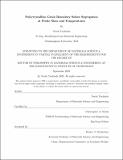Polycrystalline Grain Boundary Solute Segregation at Finite Sizes and Temperatures
Author(s)
Tuchinda, Nutth
DownloadThesis PDF (45.39Mb)
Advisor
Schuh, Christopher A.
Terms of use
Metadata
Show full item recordAbstract
Engineering defect chemistry allows novel pathways for controlling bulk material behavior, especially for high-defect-density materials like nanocrystalline alloys. With this concept, solute segregation at grain boundaries can be employed as a defect design tool to stabilize such systems against coarsening. However, the understanding and availability of grain boundary data are still limited for polycrystals that contain a profuse spectrum of grain boundary sites, especially for the effects of grain size and temperature on grain boundary site spectra. This thesis aims to fill the literature gap by providing a framework for studying grain size dependences (when grain boundary and triple junction volume fractions become finite) and solute segregation at finite temperatures where vibrational entropy becomes non-negligible.
The thesis first demonstrates extractions of triple junction segregation spectra which show characteristics of the defect type vis-à-vis grain boundaries. The developed size-dependent isotherms suggest that triple junctions can show a strong contrast of local solute content compared to adjacent grain boundaries. Although the bulk size effect can be negligible beyond approximately 20 nm in grain size due to the low junction volume fraction depending on the system chemistry and grain geometry. An analysis from an Al-based hybrid quantum mechanical-molecular mechanical dilute segregation energy dataset shows a periodic chemical trend for a cluster of solute elements with a junction segregating tendency. A further site environment analysis of the junctionpreferred solute elements suggests both chemical and elastic contributions that influence the spectrality of solute segregation and thus the energetic contrast observed.
Aside from grain junctions, temperature can play a major role in the stability of nanocrystals. This thesis demonstrates estimations of dilute site-wise vibrational segregation entropy spectra in polycrystals within harmonic approximations. The majority of the systems calculated show a positive site-wise energy and entropy correlation in agreement with the literature for simplified boundaries. The framework is extended in combination with data sciences to create a dilute segregation energy-entropy spectral database, allowing multiscale translation from site-wise segregation energy-entropy spectra to bulk McLean averages often reported in the literature and used in alloy design. The outcome demonstrates that some of the average segregation entropies reported could overestimate vibrational effects in grain boundary segregation due to the interplay between configurational and vibrational entropy in spectral grain boundary solute segregation, suggesting the importance of considering grain boundary spectrality (as opposed to McLean-type models) in interpreting grain boundary data from polycrystals.
It is hoped that this thesis can provide a better understanding of size and temperature effects in grain boundary solute segregation and serve as a pathway toward a full spectral grain boundary genome for defect-enabled material designs.
Date issued
2023-09Department
Massachusetts Institute of Technology. Department of Materials Science and EngineeringPublisher
Massachusetts Institute of Technology